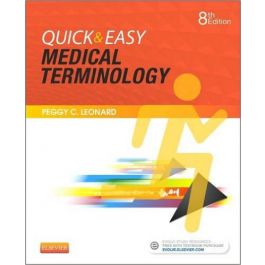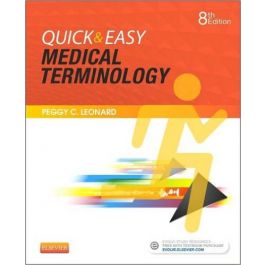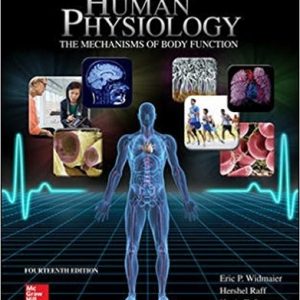Instant download Test Bank for Quick and Easy Medical Terminology 8th Edition by Leonard pdf docx epub after payment.

Chapter 02: Suffixes and Combining Forms Made Easy
Leonard: Quick & Easy Medical Terminology, 8th Edition
MULTIPLE CHOICE
1. Suture of a blood vessel is called:
a. angiectomy
b. angioplasty
c. angiorrhaphy
d. angiotomy
ANS: C REF: p. 29 TOP: Surgical Suffixes
2. Surgical puncture of the thin membrane that surrounds the fetus is called:
a. adenectomy
b. amniocentesis
c. angiorrhexis
d. glycolysis
ANS: B REF: p. 29 TOP: Surgical Suffixes
3. Pain along the course of a nerve is called:
a. neuralgia
b. neurocele
c. neuroplasty
d. neurosis
ANS: A REF: p. 36 TOP: Symptoms and Diagnostic Suffixes
4. Protrusion of all or part of an organ through the wall of a cavity that contains it is called:
a. a hernia
b. dilatation
c. edema
d. emesis
ANS: A REF: p. 36 TOP: Symptoms and Diagnostic Suffixes
5. A term that means stretching of a structure is:
a. dilatation
b. ptosis
c. prolapse
d. spasm
ANS: A REF: p. 36 TOP: Symptoms and Diagnostic Suffixes
6. The presence of abnormally large amounts of fluid in the tissues that results in swelling is called:
a. dilatation
b. edema
c. emesis
d. ptosis
ANS: B REF: p. 36 TOP: Symptoms and Diagnostic Suffixes
7. Excessive preoccupation with fire is termed:
a. hydrophobia
b. kleptomania
c. paranoia
d. pyromania
| ANS: D 8. Carcinoma is: |
REF: p. 44 | TOP: Symptoms and Diagnostic Suffixes |
a. an abnormal fear of something
b. another term for cancer
c. any disease of a body structure
d. excessive preoccupation with illness
| ANS: B 9. Prolapse means: |
REF: p. 37 | TOP: Symptoms and Diagnostic Suffixes |
a. cramping
b. discharge
c. sagging
d. rupture
ANS: C REF: p. 37 TOP: Symptoms and Diagnostic Suffixes
Copyright © 2017, Elsevier Inc. All Rights Reserved. 2
10. A word that is also a suffix that means stopping or controlling is:
a. edema
b. mania
c. ptosis
d. stasis
ANS: D REF: p. 37 TOP: Symptoms and Diagnostic Suffixes
11. Surgical repair of the eye is:
a. ophthalmalgia
b. ophthalmological
c. ophthalmoplasty
d. ophthalmorrhagia
ANS: C REF: p. 34 TOP: Surgical Suffixes
12. A surgical procedure to increase the size of the breasts is:
a. augmentation mammoplasty
b. mammography
c. mastitis
d. reduction mammoplasty
ANS: A REF: p. 33 TOP: Combining Forms for Body Structures
13. Partial or total excision of a nerve is called:
a. neurectomy
b. neurology
c. neuroplasty
d. neurosis
ANS: A REF: p. 32 TOP: Surgical Suffixes
14. A surgical procedure in which the colon is sutured to the abdominal wall is:
a. colonoscopy
b. colopexy
c. coloscopy
d. colostomy
ANS: B REF: pp. 32, 33 TOP: Surgical Suffixes
15. A term that means vomiting is:
a. amnion
b. emesis
c. endocrine
d. forensic
ANS: B REF: p. 36 TOP: Symptoms and Diagnostic Suffixes
16. The branch of medicine concerned with the administration of drugs or agents that produce loss of feeling is:
a. anesthesiologist
b. anesthesiology
c. immunologist
d. immunology
ANS: B REF: p. 26 TOP: Specialists and Specialties
17. The physician who specializes in intestinal and gastric disorders is a:
a. gastroenterologist
b. gastroenterology
c. gerontologist
d. gerontology
ANS: A REF: p. 24 TOP: Specialists and Specialties
18. The medical specialty that is devoted to treating diseases of the female reproductive organs, including the breasts, is:
a. gerontology
b. gynecology
c. pathology
d. urology
ANS: B REF: p. 24 TOP: Specialists and Specialties
19. A term that means uniting a wound by stitches is:
a. excision
b. incision
c. surgical puncture
d. suture
ANS: D REF: pp. 29, 33 TOP: Surgical Suffixes
Copyright © 2017, Elsevier Inc. All Rights Reserved. 3
20. A term that means the opposite of malignant is:
a. benign
b. cancerous
c. obstetric
d. ptosis
ANS: A REF: p. 23 TOP: Symptoms and Diagnostic Terms
21. Inflammation of the eye is called:
a. ophthalmalgia
b. ophthalmitis
c. ophthalmopathy
d. ophthalmorrhexis
ANS: B REF: p. 39 TOP: Symptoms and Diagnostic Suffixes
22. Herniation of the brain through an opening in the skull is called:
a. craniectomy
b. craniotomy
c. encephalocele
d. encephalopathy
ANS: C REF: p. 36 TOP: Symptoms and Diagnostic Suffixes
23. The term cardiologist means:
a. a heart specialist
b. any disease of the heart
c. inflammation of the heart muscle
d. study of the heart and its associated diseases
ANS: A REF: p. 20 TOP: Specialists and Specialties
24. Rupture of the eyeball is termed:
a. ophthalmocentesis
b. ophthalmorrhexis
c. otorrhexis
d. otorrhea
ANS: B REF: p. 39 TOP: Symptoms and Diagnostic Suffixes
25. Cramping of the hand is:
a. chirosis
b. cholestasis
c. chirospasm
d. colostomy
ANS: C REF: pp. 31, 40 TOP: Symptoms and Diagnostic Suffixes
26. Which of the following terms means dilation of a blood or lymph vessel?
a. angioplasty
b. vasotomy
c. vascular
d. angiectasis
ANS: D REF: pp. 36, 40 TOP: Symptoms and Diagnostic Suffixes
27. Any skin condition in which inflammation is not generally a symptom is termed:
a. cutaneous
b. dermatitis
c. dermatopathy
d. dermatosis
ANS: D REF: p. 40 TOP: Symptoms and Diagnostic Suffixes
28. Controlling the flow of blood in a vein by means of compression is called:
a. angiectasia
b. phlebostasis
c. vasoplasty
d. venosis
| ANS: B 29. Calcipenia means: |
REF: p. 40 | TOP: Symptoms and Diagnostic Suffixes |
a. abnormal fear of taking calcium
b. deficiency of calcium in the body
c. excessive preoccupation with taking calcium
d. loss of calcium owing to excessive vomiting
ANS: B REF: p. 37 TOP: Symptoms and Diagnostic Suffixes
Copyright © 2017, Elsevier Inc. All Rights Reserved. 4
30. Lithiasis is:
a. a condition in which a stone is present
b. a membrane or sac enclosing a stone
c. an unexpected symptom for a particular disease
d. the presence of disease
ANS: A REF: p. 40 TOP: Symptoms and Diagnostic Suffixes
31. The medical specialty that studies the nature and cause of disease is:
a. cardiology
b. dermatology
c. pathology
d. urology
ANS: C REF: pp. 25, 40 TOP: Specialists and Specialties
32. A term that means pertaining to the ear is:
a. dermatologic
b. neural
c. ophthalmic
d. otic
ANS: D REF: p. 24 TOP: Miscellaneous Suffixes and Combining Forms
33. An enzyme that acts on lactose is:
a. lactase
b. lactic
c. lactogen
d. lactone
ANS: A REF: pp. 42, 43 TOP: Miscellaneous Suffixes and Combining Forms
34. An enzyme that breaks down fat is:
a. adipose
b. amylase
c. lipase
d. lipid
| ANS: C 35. Amylolysis is: |
REF: p. 43 | TOP: Miscellaneous Suffixes and Combining Forms |
a. an enzyme that breaks down fat
b. an enzyme that breaks down starch
c. digestion of starch
d. excessive preoccupation with fats in the diet
ANS: C REF: p. 43 TOP: Miscellaneous Suffixes and Combining Forms
36. A drug or agent that is capable of producing a complete or total loss of feeling is called an:
a. anesthesia
b. anesthetic
c. anesthetist
d. esthetic
ANS: B REF: p. 27 TOP: Surgical Terms
37. A medical specialty that is particularly concerned with malignant tumors and their treatment is called:
a. endocrinology
b. oncology
c. ophthalmologist
d. pathology
ANS: B REF: p. 23 TOP: Specialists and Specialties
38. Which of the following terms refers to an enzyme that breaks down protein?
a. protease
b. proteinous
c. proteogenesis
d. proteolysis
ANS: A REF: p. 43 TOP: Miscellaneous Suffixes and Combining Forms
39. A term that means excessive vomiting is:
a. edema
b. hyperemesis
c. hypoglycemia
d. hysteria
ANS: B REF: p. 39 TOP: Symptoms and Diagnostic Suffixes
Copyright © 2017, Elsevier Inc. All Rights Reserved. 5
40. A method of sorting patients according to their need for care is called:
a. geriatrics
b. hospitalist
c. orthopedics
d. triage
ANS: D REF: p. 26 TOP: Symptoms and Diagnostic Terms
41. A term that means pertaining to the eye is:
a. adenic
b. ophthalmic
c. otic
d. vascular
ANS: B REF: p. 24 TOP: Miscellaneous Suffixes and Combining Forms
42. Formation of a new opening in the colon is called:
a. colitis
b. colopexy
c. coloscopy
d. colostomy
| ANS: D 43. Mastopexy means: |
REF: pp. 32, 33 | TOP: Surgical Suffixes |
a. enlarged breasts
b. inflammation of the breast
c. surgical fixation of the breast
d. surgical removal of a breast
ANS: C REF: pp. 29, 32 TOP: Surgical Suffixes
44. Excision of a small piece of living tissue for microscopic examination is called:
a. biopsy
b. emesis
c. ptosis
d. stasis
ANS: A REF: p. 33 TOP: Surgical Suffixes
45. Excision of a gland is called:
a. adenectomy
b. appendectomy
c. neurectomy
d. tonsillectomy
| ANS: A 46. Neurolysis is: |
REF: p. 32 | TOP: Surgical Suffixes |
a. loosening of adhesions surrounding a nerve
b. plastic surgery to repair a nerve
c. surgical puncture of a nerve
d. surgical removal of several nerves
ANS: A REF: p. 32 TOP: Surgical Suffixes
47. Cutaneous means pertaining to:
a. a gland
b. fats
c. the heart
d. the skin
ANS: D REF: p. 31 TOP: Combining Forms for Body Structures
48. Surgical repair of the ear is called:
a. ophthalmopathy
b. ophthalmoplasty
c. otopathy
d. otoplasty
| ANS: D 49. Dermatoplasty is: |
REF: p. 34 | TOP: Surgical Suffixes |
a. any disease of the skin
b. pertaining to the skin
c. skin grafting
d. the science that studies the skin
ANS: C REF: p. 34 TOP: Surgical Suffixes
Copyright © 2017, Elsevier Inc. All Rights Reserved. 6
50. An instrument for incising brain tissue is a(n):
a. cerebrotomy
b. cerebrectomy
c. encephalotome
d. encephalocele
ANS: C REF: p. 35 TOP: Surgical Suffixes
51. A 28-year-old woman who is pregnant is likely to see which type of physician?
a. obstetric
b. obstetrician
c. gynecology
d. gynecologist
ANS: B REF: p. 21 TOP: Specialists and Specialties
52. A 22-year-old man who was involved in a motor vehicle accident sustained a spinal cord injury. Which type of physician would
likely be involved in his care?
a. neurologist
b. neurology
c. spinologist
d. spinology
ANS: A REF: p. 43 TOP: Specialists and Specialties
53. A patient is being seen in the emergency department. The physician orders an x-ray of the patient’s arm. Which department
specializes in x-rays?
a. ophthalmology
b. orthopedics
c. pathology
d. radiology
ANS: D REF: p. 23 TOP: Specialists and Specialties
54. A physician who specializes in working with only newborns up to 28 days old is called a(n):
a. endocrinologist
b. neonatologist
c. pathologist
d. pediatrician
ANS: B REF: p. 21 TOP: Specialists and Specialties
55. A physician who specializes in working with patients who are hospitalized is called a(n):
a. epidemiologist
b. hospitalist
c. intensivist
d. internist
ANS: B REF: p. 26 TOP: Specialists and Specialties
56. The American Cancer Society recommends which test, a visual examination of the colon, once every 10 years beginning at age 50?
a. colonoscopy
b. colectomy
c. colopexy
d. colostomy
ANS: A REF: p. 31 TOP: Surgical Suffixes
57. A patient presents with complaints of muscle pain. The proper term for this is:
a. myalgia
b. neuralgia
c. ophthalmyalgia
d. otodynia
ANS: A REF: p. 31 TOP: Combining Forms for Body Structures
58. A 78-year-old man who had a blood vessel removed during surgery is likely to have which term documented in his chart?
a. angiectomy
b. angiogram
c. angiotomy
d. angioscopy
ANS: A REF: pp. 35, 49 TOP: Surgical Suffixes
59. During a physical examination, a physician can visualize the eardrum using a tool called an:
a. ophthalmoplasty
b. ophthalmoscope
c. otoplasty
d. otoscope
ANS: D REF: p. 34 TOP: Symptoms and Diagnostic Suffixes
Copyright © 2017, Elsevier Inc. All Rights Reserved. 7
60. A patient who chooses to have an augmentation mammoplasty is having a(n) _____ procedure.
a. elective
b. emergency
c. essential
d. mandatory
ANS: A REF: p. 25 TOP: Combining Forms for Body Structures
61. A 23-year-old woman who undergoes a gynecologic exam has had which system examined?
a. digestive
b. muscular
c. reproductive
d. respiratory
ANS: C REF: p. 21 TOP: Symptoms and Diagnostic Suffixes
62. Robotic surgery is sometimes referred to as minimally:
a. elective
b. extensive
c. intensive
d. invasive
ANS: D REF: p. 25 TOP: Specialists and Specialties
63. A 16-year-old woman confides in you that she has an excessive preoccupation that leads to stealing on impulse. Which term would
you document to describe her statement?
a. hysteria
b. kleptomania
c. paranoia
d. pyromania
ANS: B REF: p. 37 TOP: Symptoms and Diagnostic Suffixes
64. You are working with a 52-year-old man with a brain tumor. Which type of physician is consulted to remove the tumor?
a. neurologist
b. neurosurgeon
c. orthopedic surgeon
d. plastic surgeon
ANS: B REF: p. 25 TOP: Specialists and Specialties
65. The history of your patient lists osteomalacia. You understand that your patient has:
a. excessive calcium
b. deficiency of calcium
c. hardening of bones
d. softening of bones
ANS: D REF: p. 37 TOP: Symptoms and Diagnostic Suffixes
66. Which type of physician is most likely to perform an augmentation mammoplasty?
a. intensivist
b. internist
c. neurosurgeon
d. plastic surgeon
ANS: D REF: p. 29 TOP: Specialists and Specialties
67. A patient who has a surgical procedure to create a new opening in the windpipe has had a:
a. colostomy
b. colotomy
c. tracheostomy
d. tracheotomy
ANS: C REF: pp. 29, 31 TOP: Combining Forms for Body Structures
68. A 3-year-old boy complains of pain in his right ear. The proper term to document is:
a. myalgia
b. neuralgia
c. otalgia
d. ophthalmalgia
ANS: C REF: p. 36 TOP: Surgical Symptoms and Diagnostic Suffixes
69. While completing a chart review, you note that your patient currently has inflammation of a vein. Which of the following terms
best describes this condition?
a. appendicitis
b. dermatitis
c. mastitis
d. phlebitis
ANS: D REF: p. 40 TOP: Symptoms and Diagnostic Suffixes
Copyright © 2017, Elsevier Inc. All Rights Reserved. 8
70. A 27-year-old new mother who is breastfeeding has an infection which has led to inflammation of the breast. This can be referred
to as:
a. mammoplasty
b. mastectomy
c. mastitis
d. mastopexy
ANS: C REF: p. 39 TOP: Symptoms and Diagnostic Suffixes
COMPLETION
1. An enzyme that breaks down starch is _____.
ANS: amylase
| REF: pp. 43, 44 | TOP: Miscellaneous Suffixes and Combining Forms |
| 2. An examination of the eye is _____. ANS: ophthalmoscopy |
|
| REF: p. 34 | TOP: Surgical Suffixes |
3. An incision of the trachea is a(n) _____.
ANS: tracheotomy
| REF: p. 29 | TOP: Surgical Suffixes |
| 4. An inflammation of the appendix is called _____. | |
| ANS: appendicitis REF: pp. 37, 39 |
TOP: Surgical Symptoms and Diagnostic Suffixes |
5. Ear inflammation is termed _____.
ANS: otitis
| REF: p. 37 | TOP: Surgical Symptoms and Diagnostic Suffixes |
| 6. Pertaining to a nerve is referred to as _____. | |
| ANS: neural REF: p. 43 |
TOP: Miscellaneous Suffixes and Combining Forms |
7. Removal of the tonsils is a(n) _____.
ANS: tonsillectomy
| REF: p. 35 | TOP: Surgical Suffixes |
| 8. A skin specialist is a(n) _____. | |
| ANS: dermatologist REF: pp. 21, 31 |
TOP: Specialists and Specialties |
9. The surgical crushing of a stone is called _____.
ANS: lithotripsy
| REF: pp. 29, 30 | TOP: Surgical Suffixes |
| 10. Surgical removal of a breast is termed _____. | |
| ANS: mastectomy REF: pp. 31, 32 |
TOP: Surgical Suffixes |





